The Owl Who Was Afraid of the Dark by Jill Tomlinson, illustrated by Paul Howard, is a heartwarming children’s tale about Plop, a baby barn owl afraid of the dark. This charming story follows Plop’s journey to overcome his fear, exploring themes of bravery, family, and self-discovery. The book has become a beloved classic, offering a gentle and engaging narrative for young readers. The PDF version is widely available, making it accessible to readers worldwide.
1.1 Overview of the Book
The Owl Who Was Afraid of the Dark tells the story of Plop, a baby barn owl who fears the dark, unlike other owls. With the help of his parents and various characters, Plop learns to overcome his fear and understand the dark’s beauty. The book, written by Jill Tomlinson and illustrated by Paul Howard, is a charming tale of bravery and self-discovery. Its simple, engaging narrative makes it a beloved choice for young readers. The PDF version is widely available, offering an accessible way to enjoy this timeless story.
1.2 Importance of the Theme
The theme of overcoming fear in The Owl Who Was Afraid of the Dark is universally relatable, especially for children. Plop’s journey highlights the importance of facing fears and understanding the world from different perspectives. The story fosters empathy, self-confidence, and personal growth, making it a timeless and impactful tale for young readers; Its themes of bravery and resilience resonate deeply, encouraging children to embrace challenges and discover the beauty in things they initially fear.

The Story of Plop
Plop, a baby barn owl, fears the dark, unlike others. He wants to hunt but hesitates. With help, he learns the dark’s beauty and overcomes his fear.
2.1 Main Character: Plop the Barn Owl
Plop, a baby barn owl, is the story’s heart. He embodies curiosity and vulnerability, fearing the dark unlike typical owls; His fluffy appearance and big eyes make him relatable. Plop’s journey from fear to bravery is central, highlighting his growth. The PDF version captures his charm, making him a memorable character for young readers. His story resonates universally, teaching courage and self-discovery.

2.2 Plop’s Fear of the Dark
Plop, unlike other barn owls, is terrified of the dark, refusing to hunt with his parents. He views darkness as “nasty,” creating conflict with his natural instincts. His fear isolates him, driving the story’s emotional core. Through interactions with various characters, Plop begins to understand darkness differently. The PDF version highlights his journey, offering insights into overcoming fears and embracing change. Plop’s fear is relatable, making his growth memorable and inspiring for young readers.
2.3 Supporting Characters
The story introduces a cast of characters who help Plop overcome his fear. A small boy finds the dark exciting, an old lady sees it as kind, and a camp-fire boy views it as fun. A little girl emphasizes its necessity, while a man with a telescope sees it as wonderful, and a cat describes it as beautiful. Each perspective broadens Plop’s understanding, showing him the dark isn’t just something to fear but something to appreciate. These characters play a pivotal role in his journey toward bravery and growth.
Themes and Genres
The story blends themes of bravery, family bonds, and emotional growth, set against a backdrop of adventure and nature. It falls under children’s fiction and adventure genres.
3.1 Bravery and Overcoming Fears
Plop’s journey highlights the universal theme of bravery as he confronts his fear of the dark. With guidance from his parents and others, Plop learns to embrace the night, discovering its beauty and importance. His transformation from fear to confidence is a powerful metaphor for children facing their own anxieties. The story emphasizes that bravery is not the absence of fear but the willingness to overcome it through understanding and support.
3.2 Family and Sibling Relationships
The story beautifully portrays the supportive bond within Plop’s family. His parents guide him with patience and understanding, helping him overcome his fear of the dark. The narrative highlights the importance of family in providing comfort and encouragement. Through their interactions, the book emphasizes the value of close-knit relationships and the role of family in fostering emotional growth and resilience. Plop’s journey is not just personal but also deeply rooted in his family’s unwavering support.
3.3 Emotions and Personal Growth
Plop’s journey through fear to understanding the dark showcases profound emotional growth. The story explores various emotions, from fear and anxiety to curiosity and courage. Plop learns that the dark holds beauty and wonder, transforming his perspective. This emotional evolution is central to the narrative, teaching children the value of facing fears and embracing change. The book gently guides young readers to reflect on their own emotions and the importance of personal growth through new experiences.
3.4 Adventure and Nature
The story of Plop is a charming adventure set in the natural world, exploring the beauty of the night and the forest. Plop’s journey takes him through a hollow tree and into the dark, where he encounters various animals who share their perspectives on the night. The narrative highlights the importance of nature and the outdoors, showcasing how the darkness is filled with wonder and life. This blend of adventure and nature creates a captivating tale that inspires curiosity and appreciation for the world around us.
Author and Illustrator
Jill Tomlinson, a renowned children’s author, crafted this touching tale, while Paul Howard’s illustrations brought Plop’s journey to life, enhancing the story’s emotional depth and visual appeal.
4.1 Jill Tomlinson’s Background
Jill Tomlinson, a British author, was born in 1931 and became renowned for her charming children’s stories. Her work often explores themes of bravery, family, and nature. The Owl Who Was Afraid of the Dark remains one of her most celebrated books, showcasing her ability to craft relatable and uplifting tales for young readers. Her stories, often illustrated by Paul Howard, have captivated audiences worldwide, making her a beloved figure in children’s literature. Her writing continues to inspire and educate, leaving a lasting legacy.
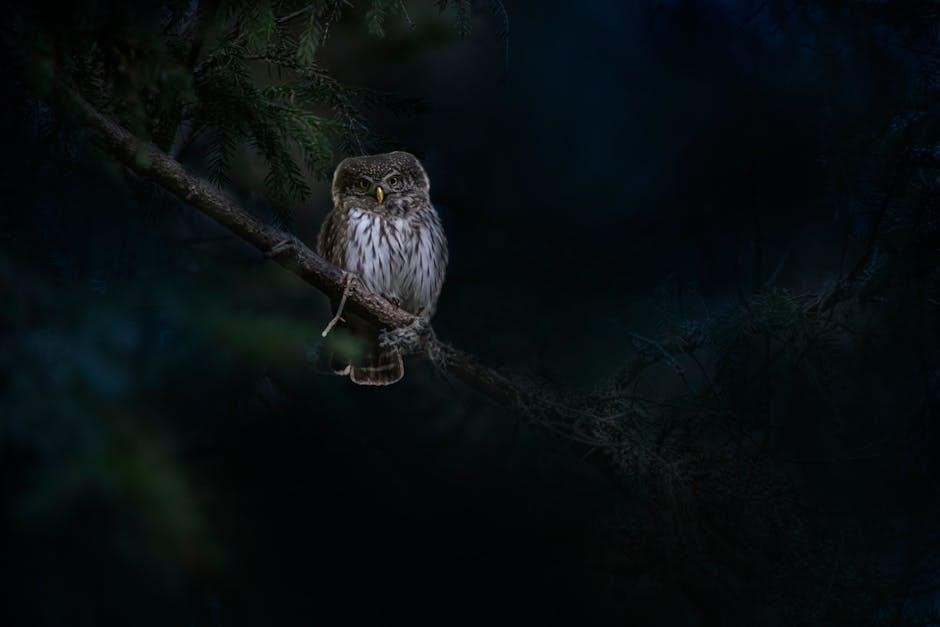
4.2 Paul Howard’s Illustrations
Paul Howard’s illustrations in The Owl Who Was Afraid of the Dark bring Jill Tomlinson’s story to life with whimsical and endearing visuals. His artwork captures Plop’s journey, blending humor and emotion seamlessly. The illustrations are intricate yet accessible, making the book a visual delight for children and parents alike. Howard’s style complements the narrative perfectly, enhancing the storytelling and immersing readers in Plop’s world. His work has been praised for its ability to convey the story’s themes with warmth and charm.
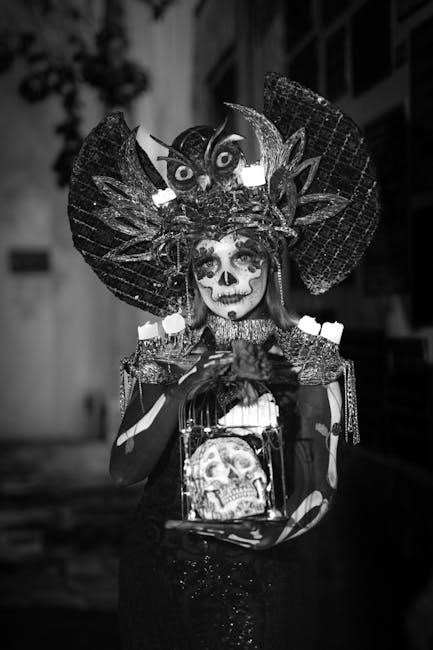
Publication Details
The Owl Who Was Afraid of the Dark was first published in 1994 by Chivers Press in Bath, England. The book is available in various editions, including paperback, hardcover, and digital formats like PDF. Its timeless appeal has led to multiple reprints, ensuring accessibility for readers worldwide. The PDF version includes additional resources, enhancing its educational and storytelling value.
5.1 Date and Publisher
The Owl Who Was Afraid of the Dark was originally published in 1994 by Chivers Press, based in Bath, England. This classic children’s book has since been released in various editions, including digital formats like PDF. The publication details highlight the book’s enduring popularity, ensuring it remains accessible to readers of all ages. The PDF version is widely available for download, making it easy for audiences worldwide to enjoy Plop’s journey in overcoming his fear of the dark.
5.2 Editions and Formats
The Owl Who Was Afraid of the Dark is available in multiple formats, including hardcover, paperback, and digital editions. The PDF version, published by Candlewick Press, includes the full story along with comprehension questions and activities. This format is accessible on various devices, making it convenient for readers. The book’s enduring popularity has led to numerous reprints and editions, ensuring it remains a favorite among children and educators alike. The PDF edition is particularly popular for its portability and educational value.
Plot Summary
Plop, a baby barn owl, overcomes his fear of the dark with his mother’s guidance and lessons from various characters, learning the dark’s beauty and necessity.
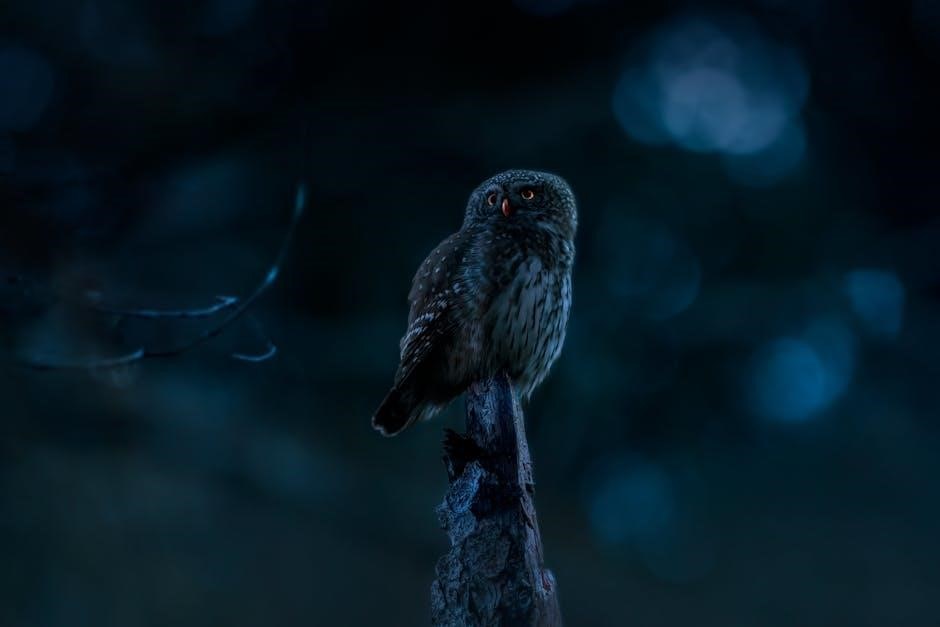
6.1 Plop’s Journey
Plop, a baby barn owl, faces his fear of the dark with the help of his mother and various characters. Each character shares their unique perspective on the dark, from exciting to beautiful. Plop learns the dark’s value through their stories, gradually overcoming his fear. With newfound bravery, he joins his father on a hunting trip, embracing the night and discovering its wonders. This heartwarming journey showcases Plop’s growth from fear to understanding, making him a relatable and inspiring character for young readers.

6.2 Lessons Learned
Plop learns that the dark is not something to fear but to appreciate. Through stories from various characters, he discovers the dark can be exciting, kind, fun, and even beautiful. Plop realizes that understanding different perspectives helps overcome fears. With his mother’s support, he learns bravery and the importance of facing fears. Ultimately, Plop understands that the dark is a natural part of life, teaching him resilience and the value of seeking knowledge to overcome anxieties.
The PDF Version
The PDF version of The Owl Who Was Afraid of the Dark is freely available for download, offering convenience and additional learning resources for readers.
7.1 Availability and Download Options
The PDF version of The Owl Who Was Afraid of the Dark is readily available for free download and online reading. It can be accessed through various platforms, ensuring easy accessibility. Some versions include additional resources like comprehension questions and activities, enhancing its educational value. The PDF format allows readers to enjoy the story on multiple devices, making it a convenient option for both children and educators. This accessibility ensures the story reaches a wide audience, fostering a love for reading and learning.
7.2 Additional Resources in the PDF
The PDF version of The Owl Who Was Afraid of the Dark often includes supplementary materials designed to enhance learning. These may feature comprehension questions, writing prompts, and engaging activities tailored for young readers. Some editions provide discussion guides for parents and educators, fostering deeper understanding of the story’s themes. Additionally, creative exercises encourage children to reflect on Plop’s journey, making the reading experience more interactive and meaningful. These resources add significant educational value to the book, enriching the reader’s engagement with the narrative.
Characters’ Perspectives on the Dark
The story presents various characters who share their positive views on darkness, such as the small boy and old lady, aiding Plop in overcoming his fear through their diverse perspectives and experiences ultimately.
8.1 The Small Boy: Dark is Exciting
The small boy shares his perspective, describing the dark as exciting. He associates it with adventures, fireworks, and the thrill of unknown possibilities. His enthusiasm helps Plop understand that darkness can be full of wonder and joy, challenging Plop’s initial fear. The boy’s lively descriptions highlight how the dark can be a time for exploration and fun, encouraging Plop to view it differently. This positive outlook is one of many perspectives that collectively help Plop overcome his fear of the dark.
8.2 The Old Lady: Dark is Kind
The old lady shares her perspective, describing the dark as kind. She explains that darkness allows her to sit quietly, reflect on memories, and forget her age. To her, the dark is a comforting space for reminiscing about good times. Her gentle wisdom helps Plop see the dark in a new light, emphasizing its role in rest and reflection. Her viewpoint adds depth to Plop’s understanding, showing how darkness can be a source of comfort and peace.
8.3 The Camp-Fire Boy: Dark is Fun
The camp-fire boy shares his enthusiasm, describing the dark as fun. He enjoys gathering around the campfire, telling stories, and roasting marshmallows. To him, the night is a time for adventure and bonding with friends. His lively perspective shows Plop that darkness can be filled with excitement and joy, offering a different way to view the night. This viewpoint highlights the social and adventurous aspects of the dark, helping Plop see its positive side.
8.4 The Little Girl: Dark is Necessary
The little girl explains that dark is necessary, emphasizing its role in the natural world. She highlights how darkness allows stars to shine and provides rest for the world. This perspective helps Plop understand that darkness is not just something to fear but an essential part of life. Her viewpoint encourages Plop to appreciate the balance between light and dark, showing how darkness contributes to the world’s harmony and beauty in its own way.
8.5 The Man with the Telescope: Dark is Wonderful
The man with the telescope shares that the dark is wonderful because it allows him to see the stars and the vastness of the universe. Through his lens, the night sky comes alive with constellations and planets, revealing the beauty of darkness. This perspective helps Plop understand that the dark is not just the absence of light but a time for exploration and wonder.
8.6 The Cat: Dark is Beautiful
The cat describes the dark as beautiful, emphasizing its natural allure and the freedom it brings. Cats thrive in the dark, using it to hunt and explore with grace. The cat explains that darkness highlights their unique qualities, like glowing eyes and silent movements. This perspective teaches Plop that darkness isn’t something to fear but rather a time when certain creatures, like cats, truly shine, showcasing the beauty of the night.

The Book’s Impact
The Owl Who Was Afraid of the Dark has become a cultural phenomenon, inspiring adaptations and captivating young readers globally. Its heartfelt story continues to resonate deeply.
9.1 Adaptations and Stage Productions
The Owl Who Was Afraid of the Dark has been adapted into a charming stage production, delighting audiences at venues like the Norden Farm Centre for the Arts in Maidenhead. The show brings Plop’s journey to life, blending storytelling, visuals, and music to captivate young viewers. Its engaging format has received positive reviews, making it a popular choice for family entertainment. The stage adaptation extends the book’s reach, helping children embrace bravery and overcome fears in an immersive way.
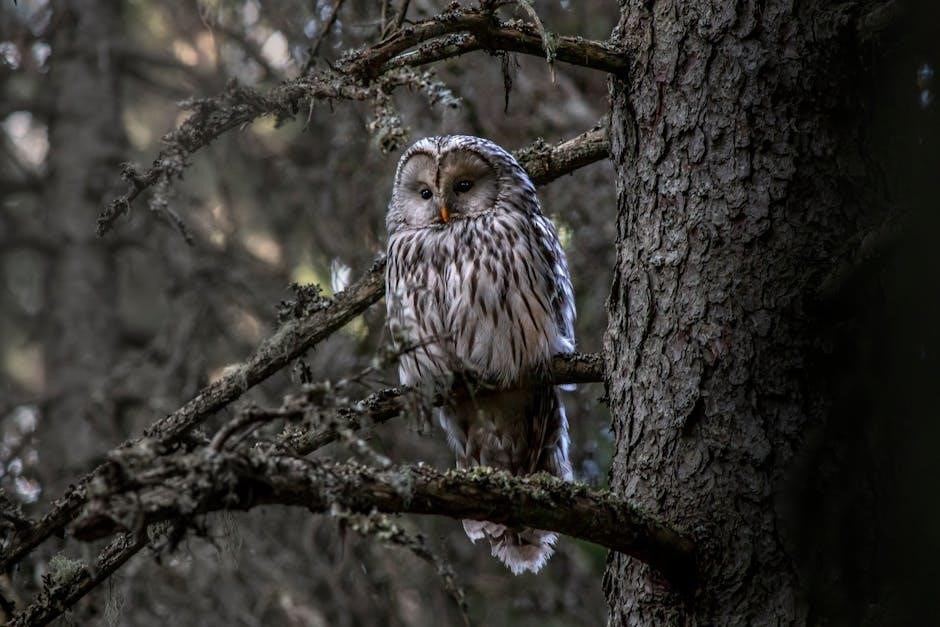
9.2 Cultural Significance
The Owl Who Was Afraid of the Dark holds significant cultural value, resonating with readers globally. Its universal themes of bravery and overcoming fears make it a timeless classic. The book’s inclusion in events like CBeebies Bedtime Stories, read by the Duchess of Cambridge, further highlights its cultural impact. It has also been adapted into stage productions, enriching its appeal. The story’s gentle narrative and relatable characters have made it a cherished part of many children’s literary experiences, fostering emotional growth and understanding.
Target Audience
The Owl Who Was Afraid of the Dark is primarily aimed at children aged 4 and above, offering a gentle and engaging story with educational value, promoting emotional growth and understanding through relatable themes.
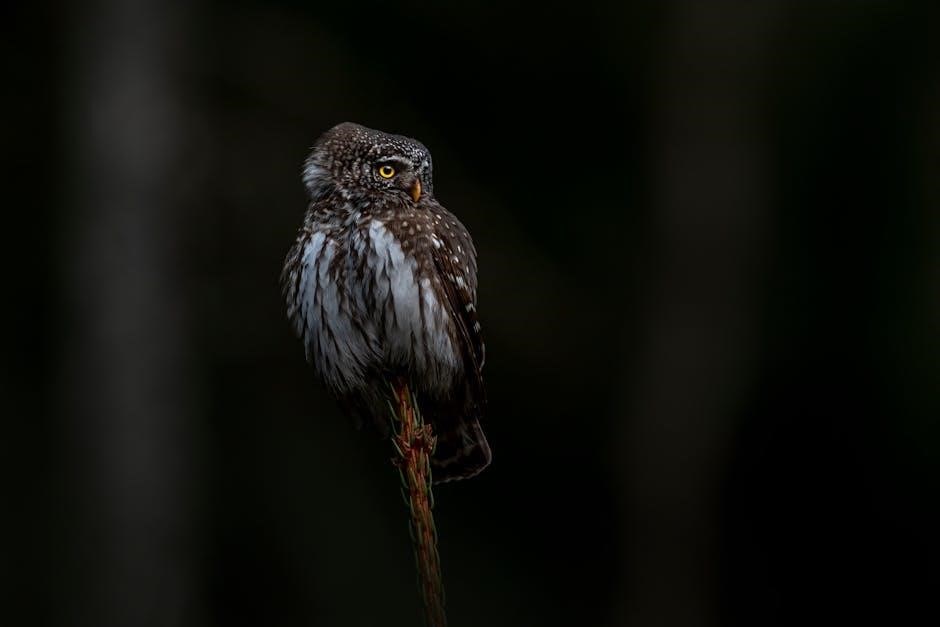
10.1 Age Group
The Owl Who Was Afraid of the Dark is ideal for children aged 4 and above, making it a perfect read for early readers or bedtime stories. The simple, engaging narrative and relatable themes of overcoming fears and family bonds resonate with young audiences. The story’s gentle tone and repetitive structure make it accessible to preschoolers, while its emotional depth appeals to slightly older children. It is also enjoyed by parents and educators seeking stories that promote emotional growth and understanding.
10.2 Educational Value
The Owl Who Was Afraid of the Dark offers significant educational value, teaching children about bravery, emotional growth, and diverse perspectives. The story encourages critical thinking through Plop’s interactions with various characters who share their views on the dark. It fosters empathy and understanding, helping children process their own fears. The PDF version includes comprehension questions, making it a valuable resource for educators and parents seeking to enhance reading and writing skills in young learners.
The Owl Who Was Afraid of the Dark is a timeless tale of bravery and growth, resonating with readers of all ages. Its universal themes and charming narrative, coupled with the convenience of the PDF version, make it a cherished and accessible read for children and parents alike.
11.1 Final Thoughts
The Owl Who Was Afraid of the Dark is a heartwarming story that resonates with readers of all ages. Its themes of bravery, family, and personal growth are timeless, making it a cherished classic. The PDF version has made the tale even more accessible, allowing families worldwide to enjoy Plop’s journey. With its charming narrative and universal appeal, this book remains a must-read for children and parents alike, offering lessons on overcoming fears and embracing the unknown.
11.2 Recommendation
The Owl Who Was Afraid of the Dark is a must-read for children and parents alike. Its themes of bravery, family, and personal growth make it a timeless classic. The PDF version’s accessibility ensures it reaches a wide audience, offering a delightful reading experience. With its engaging narrative and beautiful illustrations, it’s an excellent choice for bedtime stories or classroom discussions, fostering emotional intelligence in young minds.


